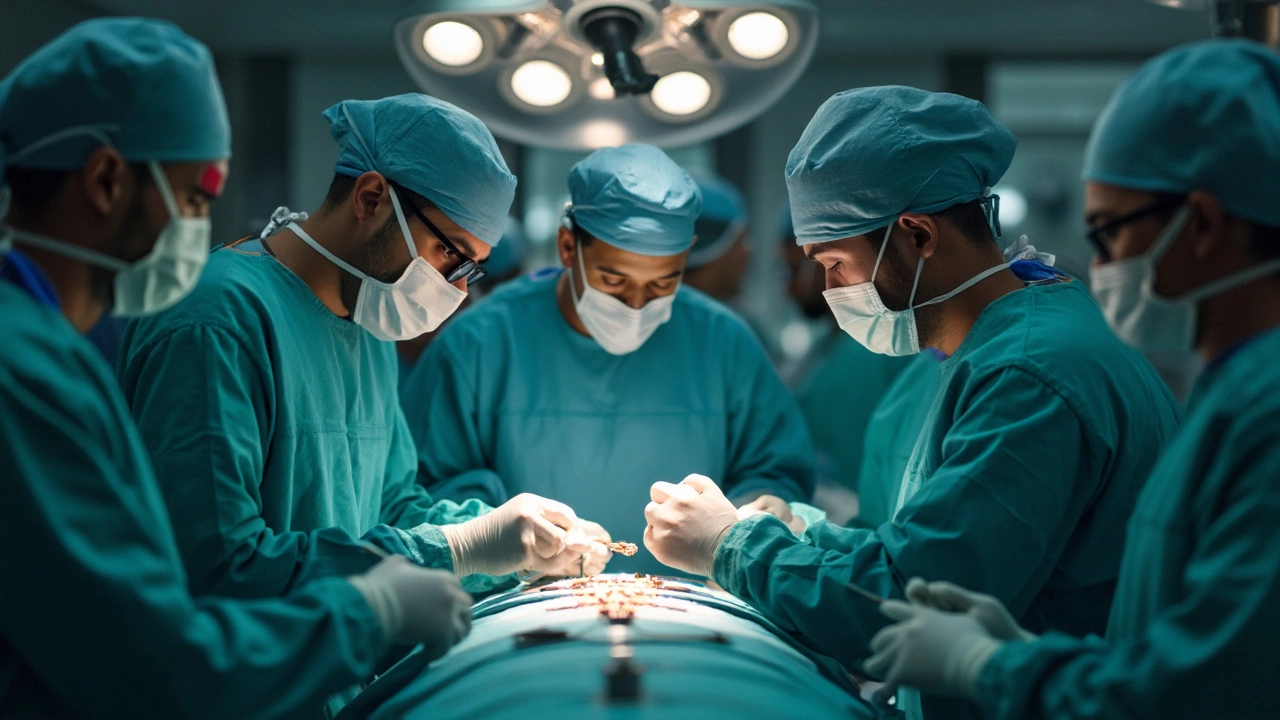When it comes to the world of surgery, heart operations are often where challenges and breakthroughs meet. But what makes heart surgery particularly risky? Simply put, it's all about the heart's vital role in our body. Whether we're talking about a coronary artery bypass or a full heart transplant, these surgeries demand precision, impeccable timing, and a whole lot of bravery from both the patient and the surgical team.
One key reason heart surgeries are so daunting is due to the heart's constant work. Imagine tinkering with an engine while it's running—it's a bit like that! Blood flow needs to be maintained even while the heart is being worked on, which adds layers of complexity.
Additionally, heart surgery often happens when a patient is already in a fragile state. Conditions like severe blockages or heart failure mean that their bodies are already fighting a tough battle. This makes the surgeon's job even harder, and any misstep can have serious consequences.
Despite these challenges, it's fascinating how far we've come. Over the years, advancements in medical technology have improved success rates dramatically, offering hope where there was once very little. New minimally invasive techniques and better heart-lung machines, for instance, have been game-changers.
Stay tuned as we explore real-life stories from patients who've undergone heart surgery, highlight key advancements in the field, and demystify why these procedures, while risky, remain essential and life-saving.
- Introduction to Heart Surgeries
- Why It's Considered Risky
- Case Studies and Real-Life Examples
- Advancements in Heart Surgery
Introduction to Heart Surgeries
Heart surgery has come a long way since its early days, but it remains one of the most risky surgeries you can undergo. It's not just about the technical challenges; it's about what's at stake. The heart, after all, keeps us alive by pumping blood and delivering oxygen to every corner of our body.
There are different types of heart surgeries, each with its own goals and challenges. Some of the most common ones include coronary artery bypass grafting (CABG), heart valve repair or replacement, and heart transplants. Each of these procedures tackles different problems within the heart, aiming to restore or improve its function.
Coronary Artery Bypass Grafting (CABG)
This is probably the most well-known heart surgery, aimed at improving blood flow to the heart. It's often performed when the coronary arteries are blocked or narrowed. The surgeon takes a vessel from another part of your body, often the leg or chest, to bypass the blocked artery. It's like creating a new pathway for blood to reach the heart.
Heart Valve Repair or Replacement
Your heart has valves that manage the blood flow between its chambers. Sometimes these valves don't work properly, which can lead to serious health issues. During surgery, these valves might be repaired or replaced with artificial ones or even valves from other animals.
Heart Transplant
A heart transplant is a big deal and is usually considered when other treatments have failed. It's when a damaged heart is replaced with a healthy one from a donor. While it's a lifesaving operation, it comes with its own set of risks and challenges, including rejection of the new heart and the lifelong need for immunosuppressive drugs.
As medical technology advances, new techniques are constantly being developed, such as minimally invasive surgeries which result in shorter recovery times and less pain. It's incredible to see how far we've come, even if the inherent risks of heart surgery can't be eliminated entirely.
Why It's Considered Risky
Heart surgeries, like the coronary artery bypass and heart transplants, come with their own set of reasons for being labeled among the riskiest medical procedures.
Complexity and Precision
Firstly, the heart is constantly in motion. In any heart surgery, doctors deal with an organ that can't just be turned off. It's like fixing a car engine while it's running full steam. This means every move has to be precise, and there's no room for error.
Patient's Health
Next up, the patient's health plays a massive role. Most people undergoing heart surgery already suffer from severe health issues like cardiac failure or artery blockages. Their bodies are often already weak, so any added stress from surgery can be a significant risk.
Risks and Complications
- Blood Clots: Surgery can increase the chance of developing blood clots, which can lead to strokes.
- Infections: There's always a risk of infection post-surgery, which can complicate recovery.
- Arrhythmias: Surgeries can sometimes disturb the heart's rhythm, causing irregular heartbeats.
Despite these risks, heart surgeries are crucial and often life-saving. The body’s dependency on a functioning heart means that these procedures, although risky, offer hope to many.
Advancements in Technology
On the brighter side, technological advancements have made heart surgeries safer. For example, minimally invasive techniques reduce recovery times and risk. Evolution in heart-lung machines also helps keep the heart and lungs functioning smoothly during the procedure.
Surgeons and researchers continue to work on minimizing these risks, developing new methods to make heart surgeries more efficient and safer every day.

Case Studies and Real-Life Examples
Diving into real-world examples can shed a lot of light on what makes heart surgery such a critical and risky procedure. Let's look at a few stories that paint a vivid picture of the challenges and triumphs encountered in the operating room.
The Miracle of a Heart Transplant
Take the case of a 45-year-old man from Mumbai who suffered from severe heart failure. His only chance was a heart transplant. Despite the risks, including immune rejection and complications, the surgery was a success, giving him a new lease on life. What made this procedure risky was the timing and precision needed to transplant a new heart while minimizing the time the circulation is stopped.
A Triple Bypass Success Story
Linda, a 67-year-old retired teacher from Pune, came face-to-face with the risks when she learned she needed a triple coronary artery bypass surgery. Her arteries were severely blocked. The operation lasted over six hours, involving complicated procedures like grafting veins from her leg to bypass the clogged arteries. Although the risk of complications lingered, like post-surgery infection or stroke, Linda came through, a testament to both her determination and the team's expertise.
Unveiling the Stats
Clearly, these are more than just individual stories; they reflect broader statistics. Over the past few years, heart surgeries have seen impressive success rates, with survival rates averaging over 90% in developed countries. Here's a simple breakdown:
| Procedure Type | Success Rate |
|---|---|
| Heart Transplant | 85% |
| Coronary Bypass | 95% |
| Valve Replacement | 92% |
Despite heart surgeries' risks, advancements continue to push the boundaries of what's possible, and these compelling case studies highlight the combination of human resilience and medical marvel that go into saving lives.
Advancements in Heart Surgery
Heart surgery has come leaps and bounds thanks to groundbreaking advancements over the past few decades. These innovations have made procedures safer, less invasive, and even more successful. But what exactly are the game-changers in this critical field?
Minimally Invasive Techniques
Gone are the days when a large incision was a must for most heart surgeries. New minimally invasive techniques allow surgeons to perform complex procedures through small cuts. These methods drastically reduce recovery time and lower the risk of infection and other complications.
Robotic Assistance
Robotic-assisted surgery is another giant leap forward. Robots now enable surgeons to carry out highly precise operations with enhanced vision and better control. It's like giving surgeons a superpower, allowing them to zero in on tiny details that could make all the difference.
Advanced Imaging Technology
Getting a clearer picture—literally—has been a big development. Advanced imaging technology like 3D and 4D scans lets doctors see the heart's structure and function in detail. This improved visualization aids in pre-operative planning and surgical precision.
Heart Transplant Innovations
For those in need of a heart transplant, the news is encouraging. Recent innovations have led to improved donor heart preservation and transportation. With devices that keep the donor heart functioning outside the body, the 'shelf life' of a heart transplant has increased, resulting in better outcomes.
Stem Cell Therapy and Regenerative Medicine
Stem cell therapy offers a glimpse into the future of heart repair. While still largely in experimental phases, early results suggest that stem cells could be used to regenerate damaged heart tissue, offering hope for those with heart disease.
| Technique | Benefit | Adoption |
|---|---|---|
| Minimally Invasive Surgery | Less recovery time | Widespread |
| Robotic Surgery | Increased precision | Growing |
| Advanced Imaging | Better planning | Widely used |
| Stem Cell Therapy | Tissue regeneration | Experimental |
These advancements in heart surgery are more than just technological feats; they're making surgeries accessible and improving the quality of life for patients worldwide. With each new development, the line between fiction and reality blurs just that little bit more, giving hope to millions.





